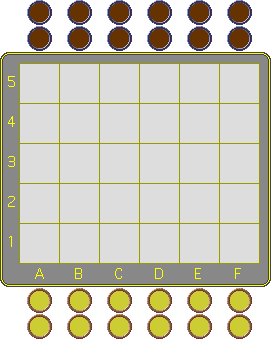 | Wiki rules The game is played on a five by six board. When the game begins, the board is empty and each player has twelve pieces in hand. In turn, players may either:
After a capture, the capturing player may remove another opposing piece of his choice. The game may end in a draw if both players have three pieces or less. |
Wiki gives a ruleset that doesn't mention multiple capture. Since capture has a strong positive feedback in that for any captured piece, another one may be removed at will, this may well be a good balancing mechanism.
However, mindful of the speed at which the game is being played in its countries of origin, an even stronger positive feedback may well be intended.
João Pedro Neto's rules
The game is played on a five by six board. When the game begins, the board is empty and each player has twelve pieces in hand. On each turn, each player may either deploy a stone from the reserve to any empty space on the board, or move a stone on the board. Stones move either by sliding to one adjacent orthogonal cell, or by jumping over and capturing an opponent stone next to them in one of those directions.
- When a stone captures another stone, the player may then select any other opponent's stone on the board (but not from their opponent's reserve) and capture it as well.
- A player may continue to jump enemy stones with the piece it has moved until it runs out of stones to jump. However, captures are not mandatory.
Wins the player who capture all of his opponents stones.
If either player is unable to move, then the game ends and the player with the most stones remaining wins.
If both players are reduced to three or less Stones, then the game is a draw.
There are two distinct interpretations regarding multiple captures:
- When a stone captures another stone, the player may then immediately select any other opponent's stone on the board and capture it as well, after which he may continue to jump enemy stones with the piece it has moved until it runs out of stones to jump, or ...
- When a stone captures another stone, the player may continue to jump enemy stones with the piece it has moved until it runs out of stones to jump, after which he may then select one additional opponent's stone on the board for every captured stone, and capture them as well.
It should be clear that the first interpretation gives additional opportunities for capture, because defending stones can be removed during the capture itself. This is positive feedback optimized.
The rule "If either player is unable to move, then the game ends and the player with the most stones remaining wins" would imply that if a player blocks an opponent who has more stones than him, loses the game. This is illogical.
No external links
